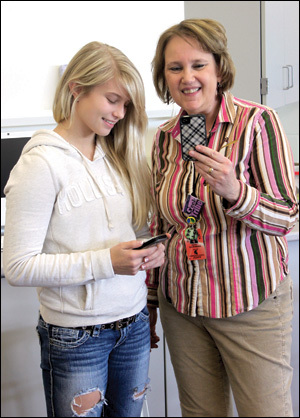Kathy Kaldenberg didn’t stir any gimlets or martinis. But her November Appy Hour did serve up a taste of applications that enable note taking, formatting citations, and streaming news—all an effort to get local educators to infuse 21st-century tools into teaching and learning.
“I wouldn’t say we’re innovators,” says Kaldenberg, district librarian at Solon Community School District in eastern Iowa. “I’m just interested in apps and want to filter them out to the departments and people who might make the best use of them.”

Student Holly Hinkel and librarian Kathy Kaldenberg
But it’s far from a passing interest for Kaldenberg, who’s building a collection of more than 150 apps culled from Diigo lists, curation sites such as Scoop.it, and Twitter, via #edapps and other hashtags. Her own favorite apps include FlipBoard, EasyBib, and Evernote [all cited in SLJ’s productivity apps feature by Linda W. Braun].
As schools increasingly adopt portable devices from Nooks to iPads, educators are turning to apps to augment classroom learning. Many are free, and that’s part of the draw for schools, which have begun acquiring apps on an institutional level and piloting their use with students.
At Solon, Kaldenberg observes her students, particularly those in middle and high school, use their smartphones to research class projects. She recommends apps in a start-of-school orientation and encourages their use in the library, in one instance, attaching QR codes to books so students can scan a summary before they check out the title.
The district is also beta testing apps in small school groups. One, ProLoquo2go, is being used with a select number of students on the autism spectrum, allowing them to click on pictures and build a sentence. A reading specialist in the district is also using app creation tool Demibooks to make ebooks that serve the specialized reading needs of her students.
While Kaldenberg enjoys seeing a growing number of kids use apps, she wants to ensure that all have access to them, even if they don’t own devices themselves.
“I think we have the obligation to try and provide equal access in the school,” she says. “We have laptops everywhere. We’re not a one-to-one school. But if you’re in school, you have access to a laptop. We don’t have tons of iPods and iPads, but we’re starting to roll them out in more classrooms. So students at least have exposure.”
Kaldenberg wants to increase that exposure—starting with teachers and administrators, who can then seed their classes with the tools best suited for the learning needs of students.
During Appy Hour, Kaldenberg provided popcorn and other treats to several teachers and administrators who showed up to better hone their app skills. She also passed out a spreadsheet with information on select apps, including the platforms on which they run. The hope was that an in-person get-together would be more engaging than the emails she pushes to colleagues notifying them of her favorite new find. Given the feedback, the event was a success.
One of the middle school administrators who attended Appy Hour visited Kaldenberg a few days later to report that he’d been test-driving apps on both his Blackberry and iPad. Now Kaldenberg plans to hold an app session, this one for high school students to get them testing and sharing, too.
“But we’re not going to call it Appy Hour,” she says, laughing. “We’ll do a seminar at lunch in the media center and have students bring in their devices and show them some academic uses for some of the apps. And they probably will teach us something, too.”



Hi
I highly recommend to use youAppi for iPad helps to find what you need
Cheers
Ronen